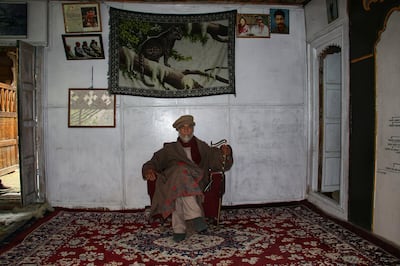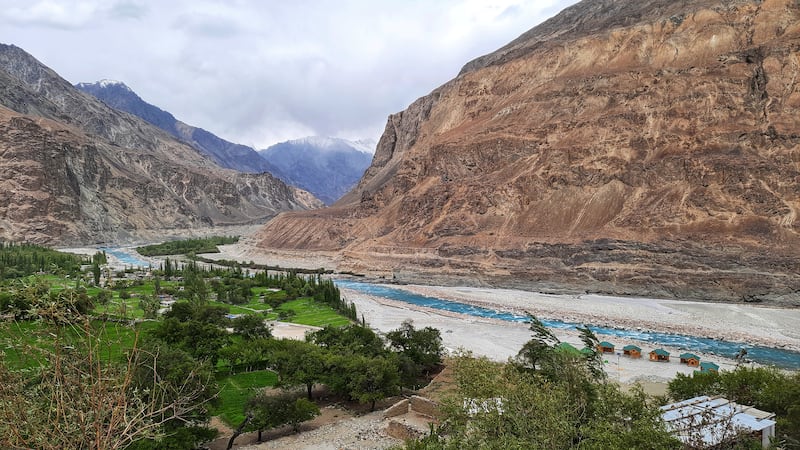The journey to Turtuk, a little village at the western edge of Ladakh’s Nubra Valley in the extreme north of India, feels never ending. The drive from Leh, about 200km away, takes more than six hours, passing through the incredibly cold Khardung La pass, about 5,359m above sea level.
The road is winding, flanked by towering bare mountains exuding a raw beauty, and valleys through which flow electric-blue streams. A cold wind blows through, slapping around anything in its path. The interminable drive feels every bit like journeying to the end of the country – which in fact it is.
When Turtuk materialises, it’s like a shocking apparition. After hours of barren brown landscape, Turtuk is lush green and fecund with orchards, crops and wild vegetation. It is situated on elevated land on the banks of the gently flowing Shyok river, with the tributary Lungpa flowing through. On either side are lofty peaks of the Himalayan and Karakoram mountain ranges. The only access into the village is by means of a footbridge – no vehicles are allowed inside.
Contiguous with the Gilgit-Baltistan region of Pakistan, Turtuk’s culture and heritage differs from the rest of Ladakh. The village is entirely Muslim and people speak Balti, a lilting mix of Tibetan and Persian. When India gained independence in 1947, Turtuk was part of Pakistan. An overnight quirk of history changed all that.
In December 1971, at the end of the Bangladesh war, the village went to sleep as part of Pakistan and woke up as part of India. Retreating Pakistani forces vacated the village and advancing Indian forces occupied it.

Hashmatullah, a young local who runs a homestay, meets me at the bridge. We walk up some steps, through narrow pathways between stone houses and past fruit orchards and buckwheat crops.
“Turtuk has a strange history; it is a village that lost its country and got taken over by another,” says Hashmat, his preferred moniker, by way of an opener.
“Families were torn apart, children were separated from parents and siblings lost touch with each other,” Hashmat says. His uncle got separated and did not meet his mother and grandmother until several decades later. The meeting is part of a documentary by Discovery Plus, available to watch in India, of which I see clips on his phone.
“Every family has a story to tell in Turtuk, you’ll see.”
The short walk brings us to Apricot Villa, a two-storey structure with windows overlooking snow-capped peaks. As night falls, it gets colder. A typical Balti meal – kisirtsamik (buckwheat pancakes with herb-laced yak curd), balay (a soupy noodle dish with vegetables) and soaked apricots, is quickly polished off. I fall asleep surrounded by the silence of the mountains and Hashmat’s words.
Dawn comes early, and I am woken by a braying donkey. In trying to locate it, I encounter a jaw-dropping sight from the window: the snow-covered peaks catch the sun’s first golden rays and glow with a surreal light. The valley below is shrouded in greyness. It is incredibly tranquil. It stays with me as Hashmat and I set out to explore the village.
We weave our way around, through a maze of narrow winding alleys and lanes flanked by small stone houses sitting cheek by jowl, a village of fewer than 100 households. There are no house numbers or street names; extended families are usually in one area. The family name is enough to navigate. Everyone knows everyone. And everyone has a story to tell. Hashmat’s family’s story echoes many of them.

We run into a marriage ceremony. The bride is swathed in a pretty, flowing beige and peach dress, her face completely covered. There is loud buzz and music. Under the shade of trees in an open area, a group of men are stirring cauldrons of food. A gentle breeze carries mouthwatering aromas. Much of the village has turned up.
We pass by, peering at the festivities, as we head to the family-run Balti Heritage House and Museum, an ancient traditional wooden and stone building on stilts. It is an effort to preserve Balti art, architecture and culture. Museum curator Sarah Ashour, whose ancestor built the house, proudly walks us through the low-roofed structure with displays of kitchen utensils, hunting equipment, garments, decor and miscellaneous items, explaining lifestyle and livelihood. Round the corner, we crouch into little stone structures that are ancient community cold storages; my teeth chatter, it’s that cold inside.
On the other side of the Lungpa, the modest stone and wooden structure of the Yabgo Palace dates back to the 15th century. The Yabgo dynasty traces its roots back to West Turkistan in Central Asia, to the Gaz tribe whose kingdom extended to Afghanistan.
Around 800 CE, a descendant, Beg Manthal, conquered the Baltistan region; they built a modest palace in Turtuk in the 15th century and reigned until the mid 19th century. It is spread across two floors with a central courtyard, exquisite murals, carved door frames and embellished balconies.
The scion of the dynasty, Yabgo Mohammad Khan Kacho traces his royal genealogy and points to the weapons and sundry artefacts of his forefathers.

We skirt the village, passing orchards of apricots, walnuts, plums, pears and apples, alpine trees, thickets, vegetable patches and swaying buckwheat crops. A short hike up a hillock takes us to a tiny Buddhist monastery, colourful flags fluttering in the brisk wind. From here, the Shyok winds like a pretty blue ribbon in a valley surrounded by soaring brown mountains. I take a few minutes to let the scene wash over me.
Later in the afternoon, we drive along the gently flowing Shyok, as it dips, crests and wraps itself around mountains. After Thang, the last hamlet, a vantage point provides views of the India-Pakistan border. Cold, harsh winds and an intermittent drizzle give the place a gloomy air. A swirling length of concertina wire makes the partition real.
Tourists arrive in waves, shouting slogans for India and posing behind a large frame with a wide border painted in military colours and the words “Nation First, Always First” emblazoned on top in red. They wear their patriotism on their sleeves.

“For decades after 1971, separated families gathered on holidays and family events to wave at each other across the border. It happens less and less now; older generations are gone and the young have made their peace,” Hashmat says sombrely.
We head back to Turtuk, quiet, lost in thought, overwhelmed by everything I had seen and heard. Sleep is a long time coming. I stare out of the window, at the silhouetted mountains and the dark sky. It is cloudless, carpeted with stars. Suddenly one streaks across, enchanting. I try to find my peace too.






